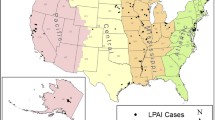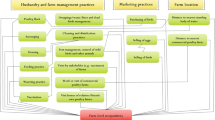Abstract
Free-range areas contribute to the welfare of poultry. Chickens are most likely to use these areas if there is sufficient cover by trees. However, wild birds in free-range areas may infect the chickens with avian influenza (AI). This study aimed to investigate the relation between the presence of AI risk birds and woody vegetation within the range areas as well as in the landscape surrounding the range areas. During two seasons all wild birds were counted in the free-range areas of 11 poultry farms and their immediate surroundings. More high-risk birds were observed in free-range areas with less than 5% woody cover, compared to free-range areas with more woody cover. Furthermore, more high-risk birds were observed in the surroundings of free-range areas in open landscapes, compared to half-open landscapes. As for low-risk birds, no relation was found between woody cover or openness of the landscape and the presence of these birds in free-range areas or surroundings. However, interpretation of the results was hampered by the incomplete factorial design, which did not allow to differentiate between the effect of woody cover within the range area and openness of the surrounding landscape. The results of this pilot study need to be confirmed with further experimental research on the relation between the presence of AI risk birds and woody vegetation in and around poultry free-range areas.
Similar content being viewed by others
References
Appleby MC, Hughes BO (1991) Welfare of laying hens in cages and alternative systems: environmental, physical and behavioural aspects. World Poult Sci J 47(2):109–128. doi:10.1079/WPS19910013
Bestman MWP, Wagenaar JP (2003) Farm level factors associated with feather pecking damage in organic laying hens. Livest Product Sci 80:133–140. doi:10.1016/S0301-6226(02)00314-7
Bray TS, Lancaster MB (1992) The parasitic status of land used by free range hens. Br Poult Sci 33:1119–1120. doi:10.1080/00071669208417554
Breed C, Duncan D, Stroud D, Nicholson R, Edwards J (2011). Annual report on surveillance for avian influenza in wild birds in member states of the European Union in 2011. European Reference Laboratory for avian influenza, Weybridge, Addlestone, Surrey, UK
Bright A, Gill R, Willings TH (2016) Tree cover and injurious feather-pecking in commercial flocks of free-range laying hens: a follow up. Anim Welf 25:1–5. doi:10.7120/09627286.25.1.001
Bubier NE, Bradshaw RH (1998) Movement of flocks of laying hens in and out of the hen house in four free range systems. Br Poult Sci 39:S5–S6. doi:10.1080/00071669888025
Dekker SEM, Aarnink AJA, de Boer IJM, Groot Koerkamp PWG (2012) Total loss and distribution of nitrogen and phosphorus in the outdoor run of organic laying hens. Br Poult Sci 53(6):731–740. doi:10.1080/00071668.2012.749342
Goot J van der, Elbers A, Bouwstra R, Fabri T, Wijhe-Kiezebrink M van, Niekerk T van (2015) Risicofactoren voor introductie van laag-pathogeen aviaire influenza virus op legpluimveebedrijven met vrije uitloop Nederland. CVI Rapport 15/CVI0078
Green LE, Lewis K, Kimpton A, Nicol CJ (2000) Cross-sectional study of the prevalence of feather pecking in laying hens in alternative systems and its associations with management and disease. Vet Rec 147:233–238. doi:10.1016/S0168-1591(01)00167-8
EFSA (2006) Opinion on ‘migratory birds and their possible role in the spread of highly pathogenic Avian Influenza’. EFSA J 357:1–46. doi:10.2903/j.efsa.2006.357
Graves AR, Burgess PJ, Liagre F, Liagre F, Pisanelli A, Paris P, Moreno G, Bellido M, Mayus M, Postma M, Schindler B, Mantzanas K, Papanastasis VP, Dupraz C (2009) Farmer perceptions of silvoarable systems in seven European Countries. In: Rigueiro-Rodríguez A et al (eds) Agroforestry in Europe: Current status and future prospects, Chapter 4. Springer Science + Business Media B.V, New York
Hirt H, Hördegen P, Zeltner E (2000). Laying hen husbandry: group size and use of hen runs. In: Proceedings of 13th IFOAM Scientific conference. Basel, Switzerland, p. 363
Kleyheeg E, Dijk JGB van, Nolet BA, Tsopoglou-Gkina D, Woud T, Boonstra D, Soons MB (2015) Daily movement distances and home range sizes of mallards (Anas platyrhynchos) are strongly affected by landscape configuration. Chapter in PhD-thesis Kleyheeg (2015): Seed dispersal by a generalist duck. Utrecht University, Utrecht, The Netherlands. ISBN: 978-90-6464-897-7
Loonen MJJE, Bos D (2003). Geese in the Wadden Sea: an effect of grazing on habitat preference. In: Wolff WJ, Essink K, Kellermann A and Leeuwe MA van (eds.) Challenges to the Wadden Sea. Proceedings of the 10th International Scientific Wadden Sea Symposium, Groningen, 2000. Ministry of Agriculture, Nature Management and Fisheries/University of Groningen, Dept. of Marine Biology, 2003, pp. 107–119
Rodenburg TB, van Krimpen MM, de Jong IC, de Haas EN, Kops MS, Riedstra BJ, Nordquist RE, Wagenaar JP, Bestman M, Nicol CJ (2013) The prevention and control of feather pecking in laying hens: identifying the underlying principles. World’s Poult Sci J 69:361–373. doi:10.1017/S0043933913000354
Veen J, Brouwer J, Atkinson P, Bilgin C, Blew J, Eksioglu S, Hoffman M, Nardelli R, Spina F, Tendi C, Delany S (2007) Ornithological data relevant to the spread of Avian Influenza in Europe (phase 2): further identification and first field assessment of Higher Risk Species. Wetlands International, Wageningen
Verhagen JH, van der Jeugd HP, Nolet BA, Slaterus R, Kharitonov SP, de Vries PP, Vuong O, Majoor F, Kuiken T, Fouchier RA (2015) Wild bird surveillance around outbreaks of highly pathogenic avian influenza A(H5N8) virus in the Netherlands, 2014, within the context of global flyways. Euro Surveill 20(12):21–32. doi:10.2807/1560-7917.ES2015.20.12.21069
Zeltner E, Hirt H (2003) Effect of artificial structuring on the use of laying hen runs in a free-range system. Br Poult Sci 44(4):533–537. doi:10.1080/00071660310001616264
Acknowledgements
This study was made possible by financial support from three projects: ‘Trees for chickens’ (funded by the European Agricultural Fund for Rural Development, the Dutch Ministry of Economic Affairs, and the Dutch Fund for Poultry Interests); ‘Low pathogenic AI on free-range farms’ (coordinated by Wageningen Bioveterinary Research, and funded by the Dutch Ministry of Economic Affairs); and the AGFORWARD EU 7th Framework Programme of RTD (Grant Agreement No. 613520).
Author information
Authors and Affiliations
Corresponding author
Rights and permissions
About this article
Cite this article
Bestman, M., de Jong, W., Wagenaar, JP. et al. Presence of avian influenza risk birds in and around poultry free-range areas in relation to range vegetation and openness of surrounding landscape. Agroforest Syst 92, 1001–1008 (2018). https://doi.org/10.1007/s10457-017-0117-2
Received:
Accepted:
Published:
Issue Date:
DOI: https://doi.org/10.1007/s10457-017-0117-2




